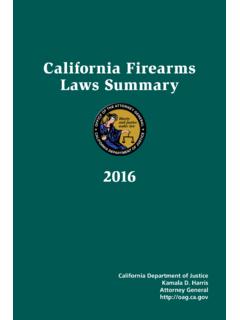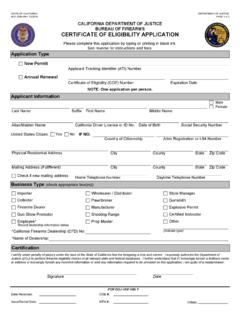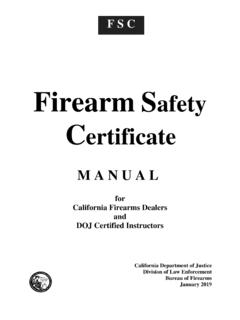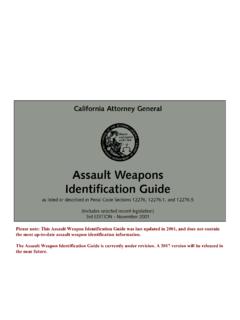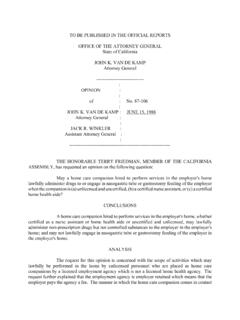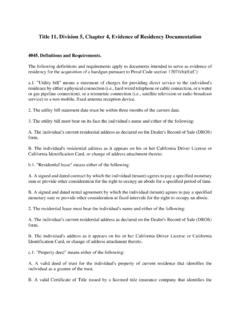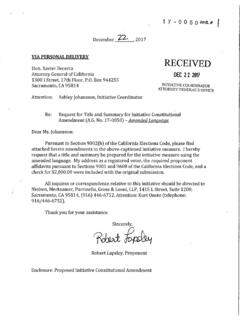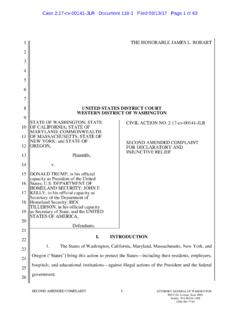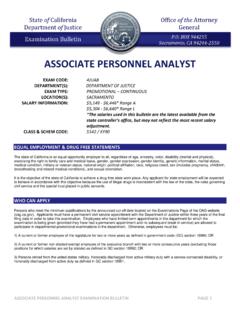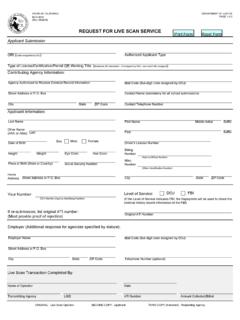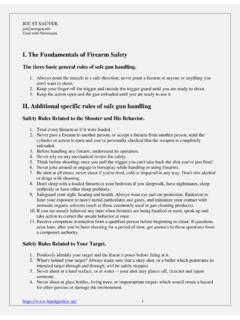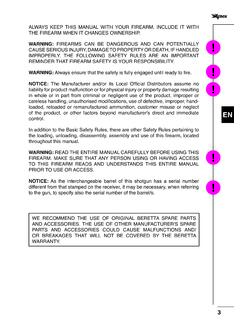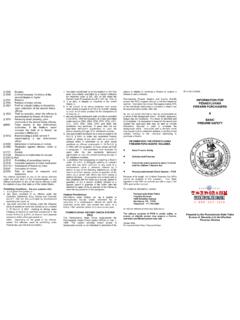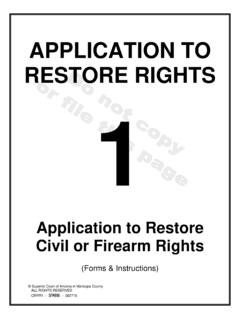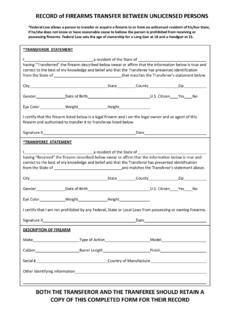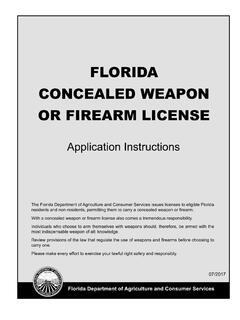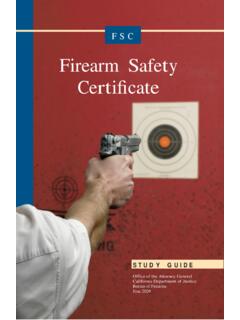Transcription of The Firearm Safety Certificate (or FSC) Study Guide, as ...
1 The Firearm Safety Certificate (or FSC) Study Guide, as read in its entirety, will provide you with basic Firearm Safety information and help prepare you for the Firearm Safety Certificate test. Firearm Safety is the law in CA. Every Firearm owner should understand and follow Firearm Safety practices, have a basic familiarity with the operation and handling of their Firearm , and be fully aware of the responsibility of Firearm ownership. Pursuant to Penal Code section 26840, any person who acquires a Firearm must have a Firearm Safety Certificate (FSC), unless they are statutorily exempt from the FSC requirement. To obtain an FSC, a person must pass a Department of Justice (DOJ) written test on Firearm Safety . The test is administered by DOJ Certified Instructors, who are often located at firearms dealerships.
2 This Study guide provides the basic Firearm Safety information necessary to pass the test. Following the Firearm Safety information in this guide will help reduce the potential for accidental deaths and injuries, particularly those involving children, caused by the unsafe handling and storing of firearms. In addition to Safety information, this Study guide provides a general summary of the state laws that govern the sale and use of firearms. Finally, there is a glossary that defines the more technical terms used in this Study guide. Simply reading this Study guide will not make you a safe Firearm owner. To be a safe Firearm owner, you must practice the Firearm Safety procedures described in the following pages. The next two pages will be the table of contents.
3 Firearm Safety is important to all Californians. Accidents involving firearms happen daily, and those involving children are especially disturbing. There may be no way to guarantee Safety , but Firearm owners can take steps to help prevent accidental shootings. Studies show that easy access to loaded firearms in homes is a major cause of accidental shootings of children. This Study guide will give you valuable information to help you become a safe and responsible Firearm owner. The intent of enacting the FSC law is to ensure that persons who obtain firearms have a basic familiarity with those firearms, including but not limited to the safe handling and storage of those firearms. To obtain an FSC, you must pass a written test prescribed by the Department of Justice.
4 The test consists of true/false and multiple choice questions. You will find the information needed to pass the test in this Study guide. There are some exemptions from the FSC requirement. A complete list of those exemptions can be found on the Attorney General s website at Ignorance and carelessness can result in Firearm accidents. They often involve people who know the Safety rules, but who are careless in following them. Remember that gun Safety rules must be applied ALL OF THE TIME. Developing a mind set for safe and responsible Firearm usage and storage is the first step in actually becoming a responsible Firearm owner. The next step is building your knowledge of firearms and gun Safety , which you can do by reading and understanding the information in this guide.
5 The final steps are becoming skillful in handling firearms and using the Safety knowledge that you have acquired. There are six basic gun Safety rules for gun owners to understand and practice at all times. Treat all guns as if they are loaded. You should always assume a gun is loaded even if you think it is unloaded; keep the gun pointed in the safest possible direction. A safe direction is one where an accidental discharge of the gun will not cause injury or damage; keep your finger off the trigger until you are ready to shoot; know your target its surroundings, and beyond; know how to properly operate your gun; and store your gun safely and securely to prevent unauthorized use. For maximum security, you should use both a locking device and a storage container.
6 Guns and ammunition should be stored separately. Please be sure to read and become familiar with each of these Safety rules. Some additional Safety points are: never handle a gun when you are in an emotional state such as anger or depression; never shoot a gun in celebration. Not only is it unsafe, it is generally illegal; never shoot at water, or at flat or hard surfaces; when handing a gun to someone or taking a gun from someone, verify it is unloaded first; avoid handling and using your gun when you are taking medications that cause drowsiness or include a warning not to operate machinery while taking the drug; avoid handling and using your gun during or after alcohol consumption; always wear ear and eye protection when shooting a gun.
7 Now take what you ve learned and see how you do on this practice test. Please feel free to pause the video in order to complete the test. You can never be too careful when it comes to children and guns. It is every Firearm owner s responsibility to take all possible steps to make sure a child cannot gain access to firearms and to be aware of all the laws regarding firearms and children. Child Safety precautions still apply even if you have no children or if your children have grown to adulthood and left home. A nephew, niece, neighbor s child, or a grandchild may come to visit. Practice gun Safety at all times. To prevent injury or death caused by improper storage of guns in a home where children are likely to be present, you should store all guns unloaded, lock them with a firearms Safety device and store them in a locked container.
8 Ammunition should be stored in a location separate from the gun. You may be guilty of a misdemeanor or a felony if you keep a loaded Firearm within any premises that are under your custody or control and a child under 18 years of age obtains the Firearm , resulting in injury or death. Children are naturally curious about things they don t know about or think are forbidden. You should address any questions children may have about firearms and be as open and honest as possible. Adults should be aware that a child can discover a gun when a parent or another adult is not present. A child should be taught the following rules in the event this should happen: 1. Stop what they are doing; 2. Don t touch the Firearm a child should never pick up a Firearm they may discover; 3.
9 Immediately leave the area this includes never attempting to take a gun away from another child or trying to stop someone from using a gun; 4. Tell an adult! Remember that actions speak louder than words. Children learn most by observing the adults around them. By practicing safe conduct you will also be teaching safe conduct. Now take what you ve learned and see how you do on this practice test. Please feel free to pause the video in order to complete the test. Pursuant to Penal Code section 26850 and 26860, prior to taking delivery of a Firearm from a licensed firearms dealer in California, an individual must correctly perform a safe handling demonstration with the Firearm he or she is acquiring. The safe handling demonstration must be performed in the presence of a DOJ Certified Instructor on or after the date the Dealer Record of Sale (DROS) is submitted to the DOJ and before the Firearm is delivered.
10 An important part of being a safe Firearm owner is knowing how your Firearm works. The two most common types of handguns are revolvers and semiautomatic pistols. Revolvers are either single or double-action. The primary difference between these two types of revolvers is the function of the trigger. The next two slides identify the safe handling demonstration for the double-action revolver. Please feel free to pause the video in order to review the safe handling demonstration for the double-action revolver. The next two slides identify the safe handling demonstration for the single-action revolver. Please feel free at this time to pause the video in order to review the safe handling for the single-action revolver. The primary difference between revolvers and semiautomatic pistols is how the ammunition is held.
